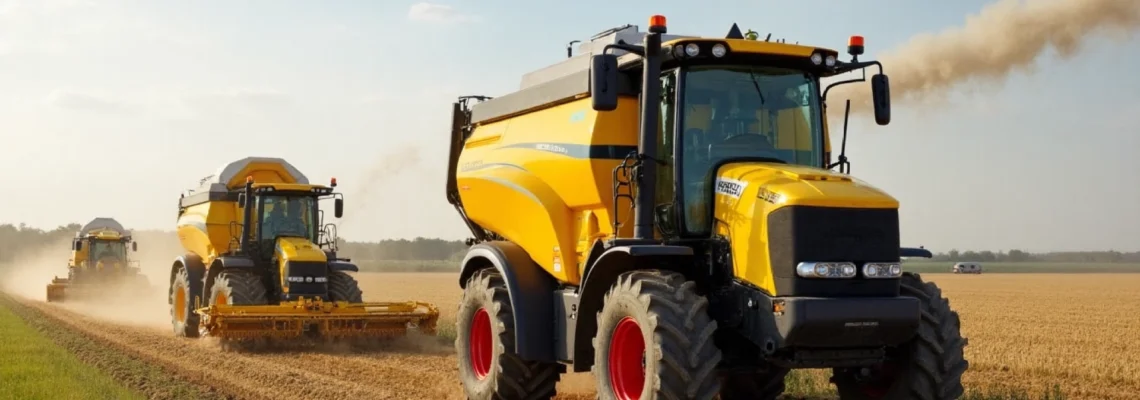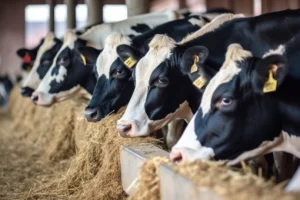Selecting the appropriate mixer feeder bucket for your farm’s needs can significantly impact livestock productivity and operational efficiency. Whether you’re dealing with dry feed, maize silage, or grass silage, the right equipment can make all the difference in ensuring a well-mixed, nutritionally balanced ration for your animals. Understanding the nuances of different mixer feeder buckets and how they handle various feed materials is crucial for making an informed decision that aligns with your specific farming requirements.
Types of mixer feeder buckets for different feed materials
Mixer feeder buckets come in various designs, each tailored to handle specific types of feed materials effectively. The primary categories include dry feed mixers, maize silage processors, and grass silage handlers. Each type incorporates unique features to address the challenges posed by different feed consistencies and moisture levels.
Understanding these distinctions is essential for farmers looking to optimize their feeding operations. The right mixer can lead to improved feed utilization, reduced waste, and ultimately, better animal performance. Let’s delve into the specific characteristics of each type to help you determine which mixer feeder bucket best suits your farm’s needs.
Dry feed mixer feeder buckets: design and functionality
Dry feed mixer feeder buckets are engineered to handle low-moisture content materials such as grains, pellets, and mineral supplements. These mixers prioritize thorough blending without compromising the integrity of individual feed components. When combined with an adaptable feeder bucket and tank for agricultural feeding, farmers can distribute dry rations more evenly, achieving consistent feed quality while saving time during distribution.
Vertical auger systems for efficient dry feed mixing
Many dry feed mixers utilize vertical auger systems, which are particularly effective for combining ingredients with varying particle sizes. The vertical design allows for a more uniform mix, ensuring that smaller particles are evenly distributed throughout the ration rather than settling at the bottom.
Vertical augers also tend to be gentler on feed particles, reducing the risk of over-processing or damaging delicate ingredients. This is especially important when working with vitamin or mineral premixes that need to maintain their structural integrity for optimal nutrient absorption.
Capacity considerations: from Small-Scale to large operations
Dry feed mixer feeder buckets come in a range of sizes to accommodate different scales of operation. Small-scale farmers might opt for compact models with capacities of 1-2 cubic meters, while larger dairy or beef operations might require mixers capable of handling 5 cubic meters or more per batch.
When selecting a mixer size, consider not only your current herd size but also any planned expansion. It’s often more cost-effective in the long run to invest in a slightly larger mixer that can accommodate future growth rather than upgrading equipment prematurely.
Key features of kuhn knight VT series for dry feed handling
The Kuhn Knight VT Series is a prime example of a mixer feeder bucket designed for optimal dry feed handling. These mixers feature a vertical auger with adjustable kicker plates that can be fine-tuned to achieve the desired mix consistency for different rations.
One standout feature of the VT Series is its ability to process long-stem hay efficiently, a task that many dry feed mixers struggle with. This versatility makes it an excellent choice for farms that incorporate a variety of dry ingredients in their feed rations.
Integrating scales and moisture sensors in dry feed mixers
Advanced dry feed mixer feeder buckets often come equipped with integrated scales and moisture sensors. These technologies allow for precise ingredient measurement and help maintain consistent moisture levels in the final mix.
Accurate weighing ensures that each batch of feed contains the correct proportions of ingredients, which is crucial for maintaining nutritional balance. Moisture sensors can alert operators if the mix becomes too dry or too wet, helping to prevent issues like dust formation or clumping that can affect feed palatability and intake.
Maize-specific mixer feeder buckets: optimizing corn silage processing
Maize silage is a staple in many livestock diets, particularly for dairy cattle. Mixer feeder buckets designed specifically for maize silage processing are engineered to handle the unique properties of this high-moisture, energy-dense feed.
Horizontal auger designs for uniform maize distribution
Many maize-specific mixer feeder buckets utilize horizontal auger systems. This design is particularly effective for processing corn silage because it allows for a more aggressive mixing action that can break down any clumps and ensure uniform distribution of kernels and stover throughout the mix.
Horizontal augers also tend to be more efficient at incorporating other ingredients into maize silage-based rations. This is crucial for creating a total mixed ration (TMR) that encourages consistent intake and reduces the potential for sorting by animals.
Corn kernel processing in patz series mixer feeders
The Patz Series of mixer feeders exemplifies the specialized approach to maize silage processing. These mixers often feature patented corn processors that crack kernels to improve digestibility while maintaining optimal particle length of the stover portion.
By effectively processing corn kernels, these mixers can significantly enhance the nutritional value of maize silage. Improved kernel breakage leads to better starch utilization in the rumen, potentially boosting milk production in dairy cattle or weight gain in beef animals.
Managing different maize particle sizes with adjustable cutting systems
Effective maize silage mixers incorporate adjustable cutting systems that can handle varying particle sizes. This flexibility is crucial because the optimal particle size can vary depending on factors such as the animal’s life stage, production level, and overall ration composition.
Adjustable knife configurations allow farmers to fine-tune the chop length of maize silage to meet specific nutritional goals. For example, a finer chop might be preferred for high-producing dairy cows to maximize energy intake, while a slightly longer chop could be beneficial for maintaining rumen health in dry cows.
Grass silage mixer feeders: tackling high moisture content
Grass silage presents unique challenges due to its high moisture content and tendency to form clumps. Mixer feeder buckets designed for grass silage must be capable of breaking down these clumps while ensuring even distribution of nutrients throughout the mix.
Twin-screw configurations for effective grass silage mixing
Many grass silage mixer feeders employ twin-screw configurations. This design provides the aggressive mixing action needed to break apart clumps of wet silage while also creating a vertical flow that helps incorporate drier ingredients uniformly.
The twin-screw system is particularly effective at maintaining the structural integrity of grass silage particles. This is important for preserving the physically effective fiber that’s crucial for proper rumen function and milk fat production in dairy cows.
Trioliet solomix mixers: specialized for grass silage handling
The Trioliet Solomix series is an excellent example of mixers optimized for grass silage handling. These mixers feature a unique auger design with adjustable knives that can be set to different positions depending on the desired mixing intensity and particle size.
One of the key advantages of the Solomix system is its ability to process both wet and dry ingredients effectively. This versatility is particularly valuable for farms that need to mix grass silage with drier components like hay or concentrates to create a balanced ration.
Preventing clumping and ensuring even distribution in wet feeds
Effective grass silage mixers incorporate features specifically designed to prevent clumping and ensure even distribution of all feed components. This might include specially shaped auger flighting, strategically placed deflectors, or programmable mixing cycles.
Some advanced models also feature automatic moisture sensing systems that can adjust mixing times or intensities based on the moisture content of the silage. This helps ensure consistent mix quality regardless of variations in silage moisture levels between batches or during different seasons.
Multi-purpose mixer feeder buckets for varied feed types
For farms that work with a variety of feed materials, multi-purpose mixer feeder buckets offer a versatile solution. These mixers are designed to handle dry feeds, maize silage, and grass silage effectively, providing flexibility in ration formulation and feed management.
Adaptive mixing technologies in faresin PF series
The Faresin PF Series exemplifies the adaptability of multi-purpose mixer feeders. These mixers feature innovative technologies that allow them to adjust mixing patterns and intensities based on the specific feed materials being processed.
One standout feature of the PF Series is its ability to automatically detect the type of feed being loaded and adjust its mixing strategy accordingly. This ensures optimal processing for each component of the ration, whether it’s breaking down clumps in wet silage or gently incorporating delicate mineral premixes.
Balancing dry and wet ingredients: mixer design considerations
Multi-purpose mixers must strike a delicate balance between effectively processing wet ingredients like silage while also handling drier components without over-mixing. This often involves a combination of different auger designs or mixing zones within the same machine.
For example, some multi-purpose mixers feature a primary mixing zone with aggressive auger action for breaking down silage, followed by a secondary zone with gentler mixing for incorporating dry ingredients. This two-stage approach helps ensure a homogeneous final mix without compromising the integrity of individual feed components.
Programmable mixing cycles for different feed compositions
Advanced multi-purpose mixer feeder buckets often include programmable mixing cycles that can be customized for different feed compositions. This allows farmers to create and save specific mixing protocols for various rations, ensuring consistent results regardless of who is operating the equipment.
Programmable cycles might include variables such as mixing time, auger speed, and reversing intervals. By fine-tuning these parameters, farmers can optimize the mixing process for each unique combination of feed materials they work with.
Selecting the right mixer feeder bucket: key factors to consider
Choosing the most appropriate mixer feeder bucket for your operation involves careful consideration of several factors. Your decision will impact not only the quality of your feed rations but also your overall farm efficiency and animal performance.
Farm size and herd management impact on mixer choice
The scale of your operation plays a significant role in determining the ideal mixer feeder bucket. Smaller farms might benefit from more compact, versatile models that can handle a variety of feed types in smaller batches. Larger operations, on the other hand, may require specialized equipment with higher capacities to meet the demands of larger herds.
Consider not only your current herd size but also your growth projections for the next 5-10 years. Investing in a mixer with slightly more capacity than you currently need can be a wise decision if you anticipate expanding your herd in the near future.
Feed ration complexity and mixer feeder compatibility
The complexity of your feed rations is another crucial factor in selecting the right mixer feeder bucket. If you primarily work with simple rations consisting of one or two main ingredients, a basic mixer might suffice. However, if you regularly formulate complex rations with multiple ingredients, including both wet and dry components, you’ll need a more sophisticated mixer capable of handling this diversity.
Consider the range of ingredients you typically use and any plans to incorporate new feed materials in the future. A mixer that offers flexibility in handling different feed types can be a valuable asset as you refine and adapt your feeding strategies over time.
Total mixed ration (TMR) strategies and equipment selection
If you’re implementing or planning to implement a Total Mixed Ration (TMR) feeding strategy, your choice of mixer feeder bucket becomes even more critical. TMR feeding requires equipment capable of thoroughly blending all dietary components into a uniform mix, ensuring that each bite contains the intended balance of nutrients.
Look for mixers with features specifically designed for TMR preparation, such as multiple mixing augers, adjustable cutting systems, and precise weighing capabilities. These features will help you achieve the consistency and accuracy necessary for successful TMR implementation.
ROI analysis: comparing mixer feeder efficiency across feed types
When evaluating different mixer feeder buckets, it’s essential to consider the return on investment (ROI) each option offers. This involves looking beyond the initial purchase price to factor in long-term operational costs, maintenance requirements, and potential impact on feed efficiency and animal performance.
Consider conducting a thorough cost-benefit analysis that takes into account factors such as fuel consumption, mixing time, labor requirements, and potential improvements in feed conversion ratios. While a more advanced mixer might have a higher upfront cost, it could potentially offer significant savings and productivity gains over its lifetime.
By carefully weighing these factors and aligning your choice with your specific farm needs and goals, you can select a mixer feeder bucket that not only meets your current requirements but also supports your farm’s long-term success and sustainability.


